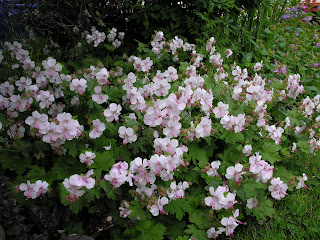Although I’ve never been accused of being short on words, there is often
this blank in my mind about where to start the article. This month I will begin
with a reminder that June is National Perennial Gardening Month. Perennials are
herbaceous plants that die back to the ground in the winter but return year
after year to dazzle us with color.
Past and present Perennials of the Year (these are proven performance perennials that have been named since 1991) are usually great choices for anyone’s garden, as they are tried and true varieties. Check the Perennial Plant Association website at http://www.perennialplant.org/ for perennial plants of the year since 1991 plus gardening tips.
My bigger focus this month will be on Pollinators and the
importance they have in our society.
With fewer honeybees these days, it’s time to welcome alternative
pollinators into your garden. We’ve all
heard the news: Populations of the honeybee are declining. Factors such as habitat loss, pesticide use,
and diseases have taken a toll on these heroes of the horticultural world.
The story that seldom gets attention is that for home
gardeners there are plenty of native pollinators. Roughly 4,000 species of bees are native to
North America, including approximately 45 types of bumblebees. Plus, many types of flies, certain wasps, and
even butterflies and bats can act as pollinators.
By attracting a diversity of these beneficial visitors, pollination
in your garden will improve. Thus,
yields of crops like tomatoes, squashes, cucumbers, peppers, and berries will
increase. You can take three steps to welcome pollinators to your garden.
1. PROVIDE NECTAR AND POLLEN RICH
PLANTS, INCLUDING NATIVES AND HERBS. The
native pollinators in our region have co-evolved with the native plants, so use
native wildflowers to draw them to your yard.
To maintain a population of pollinators, it is important to have plants
in bloom all season long. Even a small
garden can support local pollinators.
Herbs can attract native pollinators and provide them with nourishment,
too. Native plants are easy to grow
because they are adapted to our local climate and growing conditions and, once
established, are fairly low-maintenance.
2. ENSURE THAT POLLINATORS HAVE NEST
SITES. Many native pollinators nest
underground, so have some open areas.
Bumblebees often make their homes in abandoned mouse and vole tunnels,
while others prefer piles of rock. Small
bees may fly only a few hundred yards from their nest when foraging; large bees
will travel a mile or more in search of food.
Mixing pollen and nectar plants among your fruit and vegetables will
keep bees close to the plants you want them to pollinate.
Learn to enjoy your garden!
Sandi Hillermann McDonald


No comments:
Post a Comment